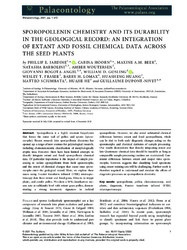Sporopollenin chemistry and its durability in the geological record: an integration of extant and fossil chemical data across the seed plants
Beer, Maxine A.M.
Woutersen, Amber
Bogota‐Angel, Giovanni
Fraser, Wesley T.
Lomax, Barry H.
Huang, Huasheng
Sciumbata, Matteo
He, Huajie
Dupont‐Nivet, Guillaume
Jardine, Phillip E.; Hoorn, Carina; Beer, Maxine A.M.; Barbolini, Natasha; Woutersen, Amber; Bogota‐Angel, Giovanni; Gosling, William D.; Fraser, Wesley T.; Lomax, Barry H.; Huang, Huasheng; Sciumbata, Matteo; He, Huajie; Dupont‐Nivet, Guillaume, 2021: Sporopollenin chemistry and its durability in the geological record: an integration of extant and fossil chemical data across the seed plants. In: Palaeontology, DOI: 10.23689/fidgeo-4044.
 |
Dokument öffnen: |
Sporopollenin is a highly resistant biopolymer that forms the outer wall of pollen and spores (sporomorphs). Recent research into sporopollenin chemistry has opened up a range of new avenues for palynological research, including chemotaxonomic classification of morphologically cryptic taxa. However, there have been limited attempts to directly integrate extant and fossil sporopollenin chemical data. Of particular importance is the impact of sample processing to isolate sporopollenin from fresh sporomorphs, and the extent of chemical changes that occur once sporomorphs enter the geological record. Here, we explore these issues using Fourier transform infrared (FTIR) microspectroscopy data from extant and fossil grass, Nitraria (a steppe plant), and conifer pollen. We show a 98% classification success rate at subfamily level with extant grass pollen, demonstrating a strong taxonomic signature in isolated sporopollenin. However, we also reveal substantial chemical differences between extant and fossil sporopollenin, which can be tied to both early diagenetic changes acting on the sporomorphs and chemical derivates of sample processing. Our results demonstrate that directly integrating extant and late Quaternary chemical data should be tractable as long as comparable sample processing routines are maintained. Consistent differences between extant and deeper time sporomorphs, however, suggests that classifying fossil specimens using extant training sets will be challenging. Further work is therefore required to understand and simulate the effects of diagenetic processes on sporopollenin chemistry.
Statistik:
ZugriffsstatistikSammlung:
Schlagworte:
sporopolleninpollen
chemotaxonomy
seed plants
diagenesis
Fourier transform infrared (FTIR) microspectroscopy
This is an open access article under the terms of the Creative Commons Attribution License, which permits use, distribution and reproduction in any medium, provided the original work is properly cited.

